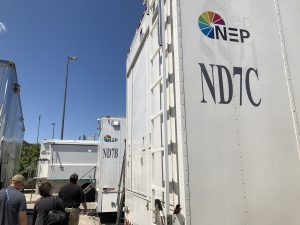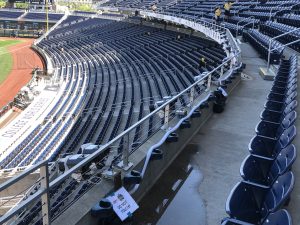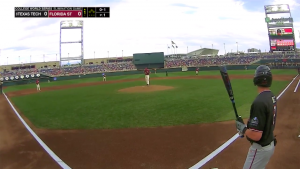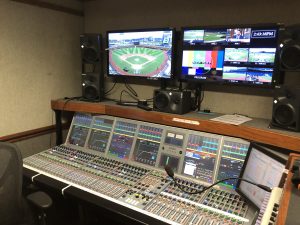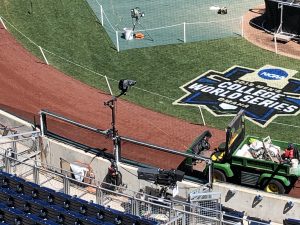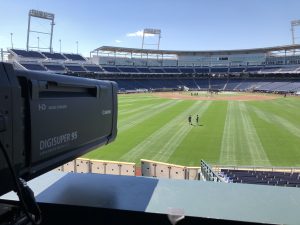Live From the College World Series: ESPN Deploys MLB-Level Tech With 4D Replay, UmpCam, Surround Coverage
The production is boosted by help from Major League Baseball and SEC Network
Story Highlights
The 2019 College World Series is a tale of two seasons. A team with multiple trips to Omaha, NE, the Vanderbilt Commodores are coming off a season that included multiple top-10 nods in the national rankings and an SEC Championship. The University of Michigan Wolverines, for their part, clawed their way to the school’s first three-game championship series by way of an at-large bid. To tell this modern-day David-vs.-Goliath story, ESPN is deploying technology usually reserved for MLB telecasts, including a 4D Replay system, a POV camera on the mask of the home-plate umpire, and all-encompassing surround coverage on ESPN3.
“The goal is to serve the baseball fan. A large amount of them are accustomed to watching Major League Baseball, so they are accustomed to technologies that are typically available only at that level,” says Chris Swihart, remote operations producer, ESPN. “Our production approach has changed a little bit this year. The overarching production support and production management are being overseen by a group of folks who also do [those] Major League Baseball games. We’re trying to bring that feel to some of our bigger college events as well.”
4D Replay Makes Its Production Debut
The Michigan Wolverines’ first appearance in the ultimate series is not the only first occurring in Omaha. Having been used for marquee games on the MLB schedule, such as the 2018 MLB All-Star Game, the 4D Replay is appearing on the college-baseball scene for the first time. Viewers at home will be able to witness all angles and details of every bang-bang play with a 180-degree display. The system comprises 100 cameras (two sets of 50) that will originate from the elevated section behind home plate and run from the first-base side to the third-base side.
“The cameras will basically calibrate one set to focus on home plate and one set to focus on the pitcher’s mound. Those are the two most likely areas for a big play,” Swihart says. “[During Louisville’s 4-3 win over Mississippi State on Thursday, June 20], we had a run-scoring play where the [4D Replay] was able to capture that the catcher didn’t quite hold onto the ball. With the little spin-o-rama effect, you were able to slide around the catcher and the umpire and see that [the runner] was able to touch the plate, avoiding the tag and getting in safely.”
Besides compiling angles, the 4D Replay system can zero in on a specific aspect of the play and zoom in without sacrificing visual clarity. Although it is used primarily to tell the cinematic story of a play, the broadcaster is leveraging the technology as a teaching tool as well.
“We have a couple of analysts on our crew that are former pitchers,” Swihart explains. “It really helps to break down [the pitcher’s mindset] because you’re able to freeze pitchers in the act. You can look at that drop and drive and how they get the power from their legs. There are all sorts of things that you can break down from a pitching standpoint, and you can kind of do the same with a hitter in the box.”
Step Into the Box: Live Looks and Replays With UmpCam
The 4D Replay may be covering the entire playing field with replays generally seen only in videogames, but fans can see a 95-mph fastball paint the black with a view from the position of the home-plate umpire. In its second-year behind the dish at TD Ameritrade Park, the UmpCam affixed to the umpire’s mask will continue to give an inside look into what the batter, catcher, and umpire see at field level.
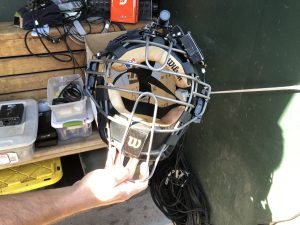
3G Wireless developed this year’s UmpCam, which combines a lightweight camera with durable/weatherproof protection.
The ESPN team had an extensive check-list of concerns when constructing the device.
“[The camera] can’t be too heavy, too bulky, or out of balance. With three-plus-hour baseball games, we don’t want it to wear on them any more than having to wear a mask normally would,” says Swihart. “We also need something with decent battery life. [And] we have to get out there and wipe off the lens to keep it clean so that the images that we get back are worth airing.”
To accomplish this feat, the network recruited 3G Wireless to develop a rugged design that could withstand a high-impact foul ball while also being lightweight.
“With cooperation and coordination with the NCAA and their umpires,” he says, “3G has been able to develop something that we’ve struggled with throughout the years. There were a lot of things that we and the developers needed to take into account, but 3G has done a great job.”
The device has the ability to adapt on a nightly basis. With a number of umpires controlling the strike zone, the UmpCam is catered to whoever is holding the post that night.
“We’ve been able to develop a system that is a little bit more versatile, so you can use it with different masks. It doesn’t have to be the same [mask],” Swihart says. “At one point [in the past], it was a Wilson model and they had to use that exact model or else it didn’t fit. In the initial incarnations of UmpCam, it was basically a glorified Marshall camera. [Now, 3G] basically went down to bare component parts to kind of build the best and brightest from several different camera systems.
In addition, the home-plate umpire will be miked, which will allow a peek into the job that they do over the course of a nine-inning ballgame, including their relationship with each team’s catcher, determining the location of a pitch, and interactions with fellow officiating crew members.
Once the camera was constructed and the audio-visual system was set to go, ESPN and 3G needed to get past another hurdle by getting the seal of approval from the participants.
“Everybody between the lines on the field will tell you that there’s a little bit more of an intimate setting, so everybody’s not always willing to share that with the masses,” he says. “From a production standpoint, we have to be a little bit choosy about how we use [the UmpCam and audio feed], so that we don’t sort of breach that trust. We want them to trust us to show interesting looks without showing and sharing more than they’d care to share with the world.”
Sights and Sounds Come to Life on ESPN3
For its sixth trip to Omaha, ESPN3’s surround coverage will leverage all the available tech being used at the park. In a technique typically used at high-profile college-football and college-basketball telecasts, the stream is generated from ESPN’s secondary cameras at the forefront, including the UmpCam and the Fletcher robos installed behind home plate and both dugouts.
“It’s not nearly as immersive because, without the announcers, we can’t do the storytelling that we can do on the [linear] broadcast,” says Swihart, “but it gives fans that opportunity to see some of the interesting technology that we have. With college football, expect to see Skycam images. With college basketball, expect to see above-the-rim [cameras]. Here at the College World Series, we have our robo cams in some of the more interesting angles that you don’t always get to see, particularly for college baseball.”
At any baseball game, the noises that cut through the air (the crack of a bat or the roar of the crowd) and those that are more subtle (the distant cry of a popcorn vendor or the pop of a glove) create a symphony of sounds that make for memorable moments. ESPN3 puts the viewer in the bleachers by pumping in a stadium-only audio track with the help of CP Communications.
“We get to take the time to sort of entrench ourselves [in audio],” Swihart says. “Anytime you get the setup for 17 games, you can build more into that setup. Because of that, the audio mix is always unbelievable. We have tons of RF crowd mics that are dedicated to parents and fans in the stands, [an array] in the outfield wall, and on both of the foul poles. You’re hearing cleats on the warning track and every slide into the bases; with any ball or player that impacts any part of the field, you get so much better and more realistic sound. It’s a great way to get a different perspective [of the game] than watching the traditional broadcast.”
Building on the MLB in Omaha Production
The College World Series crew has been in an advantageous situation over the past nine days. Earlier this month, ESPN produced the first MLB game in the state of Nebraska when the Kansas City Royals and Detroit Tigers made their way to TD Ameritrade Park. After the game was over, a majority of the onsite staff and the equipment remained in its place for its use in this tournament. One prime example is NEP’s ND7 production truck, whose four units (A, B, C, and D) have been in use. As for transmission going on inside the truck, the games will be transmitted in 720p.
Aside from the RF UmpCam and the 100 cameras used for the 4D Replay system, a lineup of 25-30 total cameras will also be used for the production. Besides the many POVs and robos on the field, there are three Sony HDC-4300’s with super-slo-mo playback (located at low home plate, tight center field, and high third base), a Fletcher-provided Sony HDC-4800 super-slo-mo with 4K capability, a jib camera from Fully Armed Productions, and a Winged Vision aerial camera.
The hardware isn’t the only technology that was left behind. The College World Series has been using K-Zone replays for pitch location, which is normally seen on Sunday Night Baseball and other MLB on ESPN telecasts. Another graphics package used on the pro and collegiate events comprises hit-tracking statistics that break down a hitter’s swing characteristics, such as launch angle, apex, and distance.
Studio programming eased the transition between both operations. From Thursday, June 13 (the night of the MLB game in Omaha) until Saturday, June 15 (the first night of the College World Series tournament), Baseball Tonight was positioned within a full set in foul territory. Host Karl Ravech and analysts Eduardo Perez, Kyle Peterson, and Tim Kurkjian manned the desk for a breakdown of games around the league and, on the first night’s show, awarded the 2019 Golden Spikes Award to Oregon State catcher Adley Rutschman.
With a heightened focus on taking the next leap toward “The Show,” Swihart and the team have packaged content that brings home that idea.
“There’s been a pretty big emphasis on showing how players get from the college level to the pros. Throughout the week, we’ve been showing former College World Series stars in the majors who are doing big things. We had a couple of DJ LeMahieu home runs and a [Alex] Gordon two-run triple in Kansas City. We’ve been showing players that have stopped here in Omaha in their college tenure en route to the majors. [The content] can create a more seamless transition from watching your favorite Major League teams to watching the College World Series.”
Offsite Support in Charlotte, Bristol for SEC Now
For the college audience, the SEC Network took over programming duties, and the conference has had a large presence at this year’s Series with four teams (Vanderbilt, Auburn, Mississippi State, and Arkansas) in the mix at the start of the tournament. The show originated from ESPN’s Charlotte, NC, facility on Friday, June 14 with host Dari Nowkhah and analyst David Dellucci but has moved to an onsite set in left field with host Peter Burns and analyst Todd Walker. With an SEC team in the title matchup, Nowkhah and analysts Chris Burke and Ben McDonald will remain in left field for a live version of SEC Now.
The show is produced from the ND7 D unit. To help with it, the SEC Network team is using the REMNAS file-transfer system to other offsite facilities. Footage is sifted through and facilitated by eight operators on 10 EVS servers (with one operator alternating between a regular server and one strictly dedicated to the Sony HDC-4800.)
“All of the clips are pushed to their servers in Bristol and Charlotte,” says Swihart. “Bristol does the primary editing, [such as] overnight edits, the tease, and the open. Charlotte can share the clips on that server as well. They’re taking those for archival purposes and [in turn] have archival footage of all of the College World Series clips in storage. We do have some onsite edit capability. We have just one machine that can do in-game packages and re-teases throughout the course of the game without having to turn it around through Bristol.”
In the booth, play-by-play commentator Tom Hart, analysts Burke and McDonald, and reporter Mike Rooney called the games of the previous rounds, but the final series will be called by Ravech on play-by-play, analysts Peterson and Perez, and reporter Kris Budden.
A Champagne Ending: Celebrating the Best in Division I
With a crew that exceeds 100, Swihart and company are reaching the closure of a long time spent in Omaha. And whether the Commodores win their second national title in school history or the Wolverines get their first taste of collegiate-baseball immortality, ESPN’s coverage of the fanfare in Omaha will be its most technologically advanced yet.
“With the help that we’ve gotten from our friends who cover Major League Baseball, as well as the actual league with some of their technologies that they were willing to lend us, it has always been a very strong tournament,” says Swihart. “It really speaks to ESPN’s commitment to getting the viewer what they want to see.
Game 1 of the 2019 College World Series between Vanderbilt University and the University of Michigan starts tonight at 7 p.m. ET on ESPN. Game 2 will follow on Tuesday, June 25 at 7 p.m. and, if necessary, the winner-take-all Game 3 will be on Wednesday, June 26 at 7 p.m.
